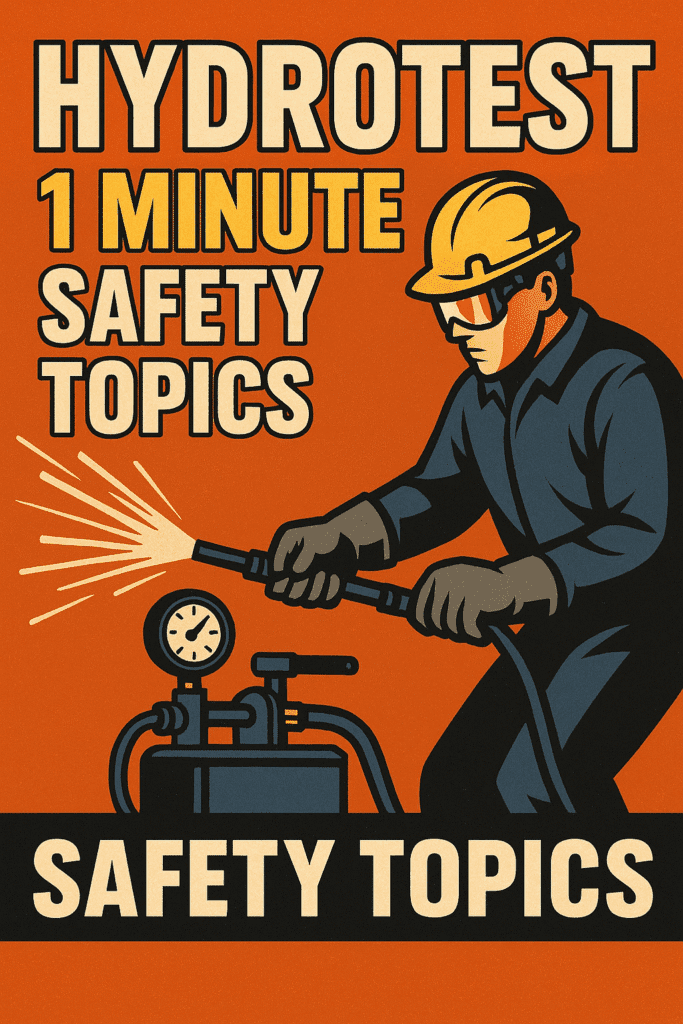
Hydrotest 1 Minute Safety Topics
Hydrotesting, or hydrostatic testing, is a critical process used to verify the strength and integrity of pipelines, pressure vessels, and tanks. It involves filling the system with water (or another liquid) and pressurizing it beyond its normal operating limits to detect leaks or weaknesses. While necessary, hydrotesting comes with serious risks like high-pressure failures, hose bursts, slips, and even equipment collapse.
That’s why 1-minute safety talks are so effective. They deliver quick, focused reminders that prepare workers to recognize and control hydrotest hazards before starting the job.
What Are 1-Minute Safety Topics?
These are short safety reminders—no more than 60 seconds—focused on one hazard or precaution at a time. For hydrotesting, these quick talks remind workers about:
- Pressure hazards
- PPE requirements
- Hose and equipment checks
- Emergency response readiness
Why Hydrotest Safety Is Critical
Hydrotesting involves working with extreme pressure, and accidents can be catastrophic. Risks include:
- Hose bursts or failures – releasing high-pressure water.
- Pipe or vessel ruptures – causing flying debris.
- Slips and falls – due to water leaks or spills.
- Noise hazards – from high-pressure discharge.
- Confined space risks – when testing tanks or vessels.
These dangers make daily safety talks essential before hydrotesting begins.
Benefits of 1-Minute Hydrotest Safety Talks
- Refresh hazard awareness every day.
- Encourage workers to double-check equipment.
- Prevent complacency during repetitive tasks.
- Reinforce teamwork and communication.
Top 10 Hydrotest 1-Minute Safety Topics
Here are key reminders you can rotate daily:
Topic 1: Pressure Awareness
Never stand in front of pressurized hoses, flanges, or valves during testing.
Message: “High pressure means high risk—stay clear.”
Topic 2: Equipment and Hose Inspection
Check hoses, couplings, gauges, and fittings for wear or damage before pressurizing.
Topic 3: PPE Requirements
Wear face shields, safety glasses, gloves, helmets, and protective footwear during testing.
Topic 4: Test Boundaries and Barricades
Clearly barricade the hydrotest area. Only authorized personnel should enter.
Topic 5: Leak Detection
Never use hands to check leaks—use boards, cloth, or paper to avoid high-pressure injection injuries.
Topic 6: Communication Protocols
Workers must know who is in charge, when pressurization starts, and when pressure is released.
Topic 7: Drainage and Slips
Water leaks create slippery surfaces. Maintain good housekeeping to prevent falls.
Topic 8: Emergency Shutdown Procedures
Workers must know how to stop the pump and depressurize safely in case of failure.
Topic 9: Confined Space Considerations
When hydrotesting tanks or vessels, follow confined space entry procedures.
Topic 10: Post-Test Checks
Ensure pressure is fully released before disconnecting hoses or fittings.
Message: “Zero pressure before disconnection.”
How to Deliver Hydrotest Safety Talks Effectively
- Focus on one key hazard at a time.
- Keep it under one minute.
- Use real-life examples of incidents or near misses.
- Ask workers: “What’s today’s biggest hydrotest hazard?”
Mistakes to Avoid
- Overloading workers with technical details.
- Skipping PPE reminders.
- Assuming everyone knows the risks already.
Conclusion
Hydrotesting ensures equipment safety, but the process itself can be dangerous. A 1-minute safety talk each day can make the difference between a safe test and a catastrophic accident.
Remember: “Pressure may test the system, but awareness protects the workers.”
Painting 1 Minute Safety Topics
Chemical 1 Minute Safety Topics
Scaffolding 1 Minute Safety Topics
Confined Space 1 Minute Safety Topics
Excavation 1 Minute Safety Topics
FAQs
1. What is the main risk in hydrotesting?
Hose or equipment failure under high pressure.
2. Should hydrotest areas be barricaded?
Yes, to keep unauthorized personnel out of danger zones.
3. How do you safely detect leaks?
Use a board, rag, or paper—never your hands.
4. What PPE is required for hydrotesting?
Helmet, face shield, gloves, goggles, and safety footwear.
5. When can hoses be disconnected?
Only after the system is completely depressurized.